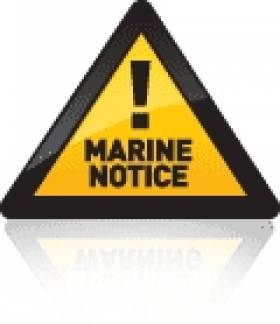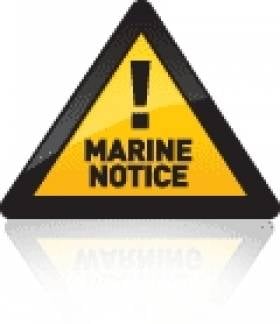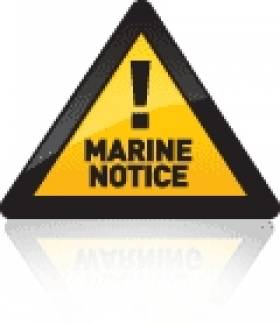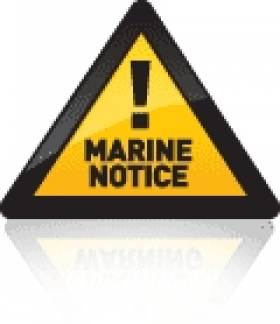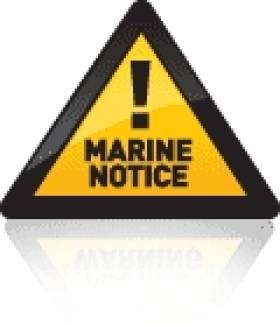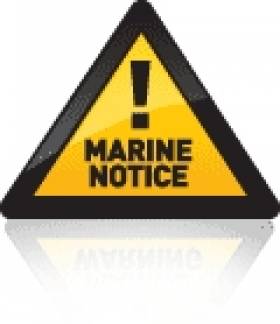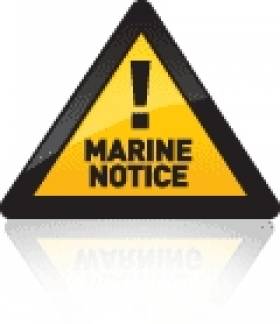Displaying items by tag: Marine Notice
#MarineNotice - The latest Marine Notice from the Department of Transport, Tourism and Sport (DTTAS) advises of rock placement on the newly installed P3/P6 flowlines at the Corrib gas field, and remedial rock placement on the 20” gas pipeline and control umbilical.
The work will be undertaken at the Corrib field location and along the pipeline corridor to the landfall at Broadhaven Bay. The vessel to be used will be the Nordnes (Callsign PHOG).
Work on the P3 and P6 flowline rock placement will all take place within the 500m Safety Zone surrounding the Corrib subsea facilities. Meanwhile, the pipeline and umbilical remedial rock placement will be undertaken from the Corrib offshore field location to landfall at Glengad, Co Mayo.
The P3/P6 rock placement works will commence tomorrow, Sunday 19 October at the Corrib Field. Following that, the remedial rock placement will be undertaken on the pipeline and umbilical. The work will be completed by early November 2014.
Full details of co-ordinates for the relevant work areas are included in Marine Notice No 59 of 2014, a PDF of which is available to read or download HERE.
Marine Notice: Statutory Radio Surveys On Irish Sea-Going Vessels
#MarineNotice - The latest Marine Notice from the Department of Transport, Tourism and Sport (DTTAS) advises that it has established a panel of authorised surveyors to conduct statutory radio surveys on Irish sea-going vessels, including fishing vessels.
This panel is established from 1 October 2014 till 1 October 2017. Owners of vessels in the following categories requiring a periodical/annual radio survey should contact a panel radio surveyor to arrange these surveys:
• Irish fishing vessels of 15 metres length overall or more,
• Irish domestic trading passenger ships of Classes B, C, D, II(A), III, and VI,
• Irish domestic trading cargo vessels of 300GT or more, but less than 500GT.
On completion of such surveys, the panel surveyors will inform the Marine Survey Office (MSO) with regard to the issue of any required statutory certificate to the vessel.
In general, from 1 January 2015 the MSO will not issue statutory certificates to vessels which have not completed the required statutory radio survey. Owners of vessels requiring an 'initial' radio survey should contact the MSO.
Operators of vessels where the statutory certificates are issued by a Recognised Organisation on behalf of the DTTAS should continue to utilise the services of the Recognised Organisation for the completion of these statutory radio surveys.
Contact details for the panel of surveyors are included in the annex to Marine Notice No 58 of 2014, a PDF of which is available to read or download HERE.
Marine Notice: Corrib Gas Field Baseline Environmental Survey & Post Well Monitoring Survey
#MarineNotice - The latest Marine Notice from the Department of Transport, Tourism and Sport (DTTAS) advises that an environmental survey will take place in the vicinity of the Corrib Gas Field manifold and the Corrib treated surface water outfall diffuser.
These works, which include a post-well environmental survey conducted in the area of the 18/20-5(P6) well, were scheduled to commence by today (Friday 26 September) and are expected to last about a week, weather permitting. The vessel to be used is the Granuaile (Callsign EIPT).
Water and sediments samples will be collected from a series of locations adjacent to the Corrib field (SW3) and the water outfall diffuser (SW1) using a grab sampler. All locations at SW3 are within a 2.5km radius of the manifold.
With the exception of a sample control site located approximately 10km to the south-west, all locations at SW1 are within 4km of the diffuser. Cameras mounted on ROVs will take visual images of the seabed at each sample location.
Details of the relevant co-ordinates are included in Marine Notice No 57 of 2014, a PDF of which is available to read or download HERE.
Marine Notices: Survey Operations In The Celtic Sea, Off Southwest Coast
#MarineNotice - The latest Marine Notice from the Department of Transport, Tourism and Sport advises that Osiris Projects will be carrying out two survey operations along the proposed interconnector route between Ireland and France.
The surveys will extend from the Shoreline at two locations in Co Cork (Ballinwilling Strand main route and Ballycroneen Beach alternative route) across the Celtic Sea to the shoreline at two locations in Northern France (Roscoff main route and Pontusval alternative route).
The first survey operation started on 17 August and is expected to run until 30 September, weather permitting. Survey works will be undertaken on the survey vessel RRS Ernest Shackleton (Callsign ZDLSI).
The vessel will operate on a 24-hour basis, will display appropriate day shapes and lights during survey operations and will actively transmit an AIS signal.
The RRS Ernest Shackleton will be towing survey equipment below the surface up to 600m behind the vessel. A wide berth is requested at all times as the vessel will be restricted in her ability to manoeuvre.
The second survey operation was expected to start on the Irish side yesterday (10 September) and will run until 20 September, weather permitting. Survey works will be undertaken on the survey vessel MV Proteus (Callsign 2HBL7).
The vessel will operate on a 12-hour basis, will display appropriate day shapes and lights during survey operations and will actively transmit an AIS signal.
The corridor width for each landing will be 250 metres from the high water mark to the 10-metre contour, then the corridor will widen to 500 metres as the route moves to France.
The survey vessel may be found running both along the corridor and in the general vicinity of the survey corridor. The vessel will be working between high water and 20 metre contour and in daylight hours only.
The MV Proteus will be towing survey equipment on and below the water surface up to 300m behind the vessel. A wide berth is requested at all times as the vessel will be restricted in her ability to manoeuvre.
Both vessels will be listening on VHF Channel 16 throughout the works. Full details of co-ordinates of the work areas are included in Marine Notice No 55 of 2014, a PDF of which is available to read or download HERE.
Meanwhile, a hydrographic and geophysical survey operation is presently being undertaken by INFOMAR on the RV Celtic Voyager off the southwest coast of Ireland, continuing till 17 September.
The vessel is towing a magnetometer sensor with a single cable of up to 100m in length. A wide berth is requested at all times as the vessel will be restricted in her ability to manoeuvre.
The vessel will display appropriate lights and markers, and will be listening on VHF Channel 16 throughout the project.
Co-ordinates for the bounding box of the survey area are detailed in Marine Notice No 54 of 2014, a PDF of which is available to read or download HERE.
Marine Notice: Corrib Gas Pipeline & Umbilical Inshore Maintenance & Inspection Survey
#MarineNotice - An inshore pipeline and umbilical maintenance and inspection survey, using vessel mounted acoustic survey equipment and a side scan sonar system, will take place from high water at Glengad, Co Mayo to an area close to the water outfall diffuser.
Works will commence around Monday 8 September and are expected to last for approximately two weeks.
The vessel to be used is the Naomh Aine (Callsign EIDU7). The Macbel (Callsign EIHL5) safety vessel will be operating with the Naomh Aine at all times.
All other vessels in the vicinity are advised to keep a wide berth from the work vessels.
Details of co-ordinates for the work area are included in Marine Notice No 53 of 2014, a PDF of which is available to read or download HERE.
Marine Notice: 3D Seismic Survey In Porcupine Basin, September 2014
#MarineNotice - The latest Marine Notice from the Department of Transport, Tourism and Sport (DDTTAS) advises that Polarcus DMCC is scheduled to carry out a 3D seismic survey in the Porcupine Basin, southwest coast of Ireland, in early September.
The survey will cover 633 sq km and is is expected to last for around 20 days, subject to weather.
The seismic vessel M/V Polarcus Amani (Call sign C6ZD3) is scheduled to carry out the work. The vessel will be towing 10 cables, each 8.1km long with 150m separation at depth of 14 metres, with a total array width of 1.35km.
A buoy equipped with a radar reflector and navigation strobe light will be deployed at the end of each cable.
The seismic vessel will be accompanied by support vessel M/V Bravo Sapphire (Call sign ZDJY8) and chase vessel M/V Nomad (Call sign EI5298). All work vessels will be listening on VHF Channels 16 and 67.
The seismic vessel in particular will be restricted in its ability to manoeuvre while carrying out the survey so all vessels, particularly those engaged in fishing, are requested to give the M/V Polarcus Amani, her towed equipment, the M/V Bravo Sapphire and the M/V Nomad a wide berth and keep a sharp lookout in the relevant areas.
Co-ordinates for the proposed seismic 3D survey are included in Marine Notice No 52 of 2014, a PDF of which is available to read or download HERE.
Marine Notice: AIM Requirements For Seagoing Passenger Ships
#MarineNotice - As of 31 October 2014, there will be new requirements for Automatic Identification Systems (AIS) for passenger ships of classes B, C, D, IIA, III and VI.
The European Communities (Vessel Traffic Monitoring and Information System) Regulations 2010 [SI No 573 of 2010] as amended by the European Communities (Vessel Traffic Monitoring and Information System) (Amendment) Regulations 2012 [SI No 71 of 2012] include the requirements for approved AIS to be fitted on vessels.
Regulation 9A sets out the scope for exemptions from the requirements of Regulations 8 and 9, which may include passenger ships below 15 metres in length or 300 gross tonnage engaged on non-international voyages, and Marine Notice 22 of 2012 refers to such exemptions from the requirements to fit an approved AIS for domestic passenger vessels of less than 15m or 300GT.
Vessels less than 15 metres in length will in general be exempted from the requirement to fit an approved AIS (ie, one which satisfies the performance standards drawn up by the International Maritime Organisation) but will, in most cases, be required to fit AIS type B.
The specific exemption criteria and conditions thereof, together with the detailed carriage requirements for AIS on seagoing domestic passenger vessels are set out in the annex to Marine Notice No 51 of 2014, a PDF of which is available to read or download HERE.
The Marine Survey Office will verify compliance with the carriage requirements and the operation of the AIS during annual surveys and inspections of passenger vessels from 31 October.
Sediment Sampling at An Daingean Fishery Harbour Centre
#shipowners – The Department of Transport, Tourism and Sport has been advised that Site Investigation works will commence at An Daingean Fishery Harbour Centre, Co. Kerry, weather permitting, on or around 19th August 2014. The works will involve sediment sampling/analysis and ground investigation works in the eastern basin.
The works are being advanced by a site investigation crew working from a Pontoon using engineering plant and machinery and work vessels.
For safety reasons, mariners are requested to proceed slowly and with caution in the approach to the eastern basin of the Fishery Harbour Centre and to give the site investigation works a wide berth. Wave-wash from vessels should be avoided.
These works are expected to be on-going until the end of August 2014, weather permitting.
For further information, contact An Daingean Harbourmaster's Office Tel: + 353 (0)66 9151629.
Irish Maritime Administration,
Department of Transport, Tourism and Sport,
Leeson Lane, Dublin 2, Ireland.
Marine Notice: 2D Seismic Survey In South Porcupine Basin
#MarineNotice - Seabird Exploration FZ LLC is scheduled to carry out a 2D seismic survey in the South Porcupine Basin off the southwest coast of Ireland.
Acquisition of 4,500km of seismic data is anticipated to commence shortly with an expected duration of 45 days, subject to weather.
The seismic vessel M/V Harrier Explorer (Call sign 3EIE3) is scheduled to carry out the work.
The vessel will be towing one 10km cable at a depth of 14 metres. A buoy equipped with a radar reflector and navigation strobe light will be deployed at the end of the cable.
The seismic vessel will be accompanied by guard vessel M/V Stormbas (Call sign HO4190), and will be restricted in its ability to manoeuvre whilst carrying out the survey. Both work vessels will be listening on VHF Channels 16 & 67.
All other vessels, particularly those engaged in fishing, are requested to give the M/V Harrier Explorer, her towed equipment, and the M/V Stormbas a wide berth and keep a sharp lookout in the relevant areas.
Details of co-ordinates for the survey area are included in Marine Notice No 49 of 2014, a PDF of which is available to read or download HERE.
Marine Notice: Construction Works At Westcove Harbour
#MarineNotice - Further to Marine Notice No 13 of 2014 from January this year, the Department of Transport, Tourism and Sport has been advised that construction works were scheduled to commence at Westcove Harbour in Co Kerry from yesterday 7 August.
The works will mainly take place at the mouth of the harbour (51° 46' 3.3738" North, 010° 02' 56.7204" West) and will involve the installation of a new navigation beacon, 5-6m in height, at the mouth of the harbour as well as the upgrading of two leading lights located within the harbour.
The works are being advanced by the Marine Engineering Division of the Department of Agriculture, Food and the Marine. The construction will involve use of a work vessel 20m × 7m in size carrying civil engineering plant and machinery, as well as other smaller work vessels and platforms.
The work vessel will display the relevant day signals and navigation lights in accordance with the Collision Regulations.
For safety reasons, mariners are requested to proceed slowly and with caution in the approach to the entrance to Westcove Harbour and to give the works a wide berth. Wave-wash from vessels should be avoided.
These works are expected to be on-going until early September 2014, weather permitting. For further information, contact Marine Engineering Division Office at 066 714 9340.


























